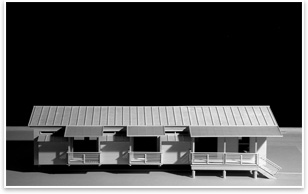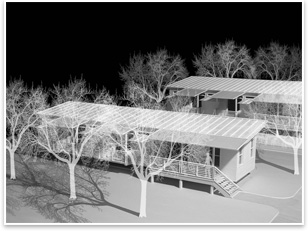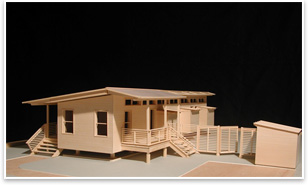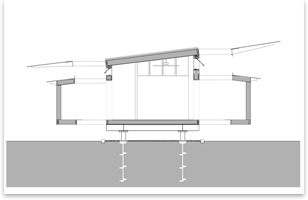SUSTAINABILITY
Factory-Built Housing: The Green Alternative
by Michael J. Crosbie, PhD, AIA
Contributing Editor
 Summary: Over the past century, factory-built housing has occupied a unique niche for architects. In the early years of Modernism, the factory-built house promised to achieve what for some Modernists was the epitome of a new architecture: buildings that looked like machines, made by machines. The expansion of the U.S. economy after World War II was a boon for factory-built housing. It seemed as though everyone, sooner or later, would be living in a factory-built house in the suburbs, delivered by truck or on a trailer. Lustron Homes, the Acorn House, and other factory-made abodes captured the optimistic ideal of quick, affordable, state-of-the-art housing. Summary: Over the past century, factory-built housing has occupied a unique niche for architects. In the early years of Modernism, the factory-built house promised to achieve what for some Modernists was the epitome of a new architecture: buildings that looked like machines, made by machines. The expansion of the U.S. economy after World War II was a boon for factory-built housing. It seemed as though everyone, sooner or later, would be living in a factory-built house in the suburbs, delivered by truck or on a trailer. Lustron Homes, the Acorn House, and other factory-made abodes captured the optimistic ideal of quick, affordable, state-of-the-art housing.
 The reality was a bit different. Houses that looked like machines never caught on with the general public. To this day, manufacturers of factory-built housing do their best to make their products look like traditional, stick-built houses. And architects continue to try to make factory-built houses look like, well, machine-made objects. The current craze (or nostalgia) among architects for factory-built homes evidenced in such books as Prefab and traveling exhibits continues to push the idea of houses as machines. Factory-built housing manufacturers, meanwhile, are busy developing new ways to make folding dormers, sloped roofs, and prefab mansards. They understand that the bigger market share is in traditional-looking housing. The reality was a bit different. Houses that looked like machines never caught on with the general public. To this day, manufacturers of factory-built housing do their best to make their products look like traditional, stick-built houses. And architects continue to try to make factory-built houses look like, well, machine-made objects. The current craze (or nostalgia) among architects for factory-built homes evidenced in such books as Prefab and traveling exhibits continues to push the idea of houses as machines. Factory-built housing manufacturers, meanwhile, are busy developing new ways to make folding dormers, sloped roofs, and prefab mansards. They understand that the bigger market share is in traditional-looking housing.
And for architects, that should be OK. After 100 years, architects should be resigned to the fact that we are never going to change popular taste. But factory-built housing is worth pursuing because it offers the best alternative for green housing. Speed and convenience were once the touchstones of factory-built housing, but, today, sustainability is easier to achieve by building in a factory for a number of reasons.
 Greener than stick-built Greener than stick-built
Controlling the environment in which the building is constructed is key. Building houses outdoors can result in materials that become wet before installation, which then breed mold and contribute to bad indoor air quality afterward. The factory environment eliminates this problem. Factory-built housing is also rationalized so that there is very little material waste—resulting in better resource conservation. Dumpsters piled with waste (a staple of stick-built home sites) are not found in factories. Under controlled factory conditions, it’s also possible to get a tighter, more efficient building envelope with higher insulation values and better thermal performance.
According to industry estimates, factory-built housing accounts for more than half of all the units built in this country every year. Included are manufactured homes (commonly referred to as “HUD-Code,” “mobile homes,” or “trailers”), modular homes, panelized homes, and hybrids of these systems. Because of their widespread use and the fact that they are potentially greener than stick-built, factory-built homes are worth the architect’s attention.
 An example from Mississippi An example from Mississippi
Architect Michael Berk, a professor at Mississippi State University, has been pursuing research in this area with his GreenMobile home, a manufactured home designed to boost sustainability through such measures as higher insulation levels (achieved through the use of structural insulated panels), energy-efficient appliances (many of them with Energy Star ratings from the Department of Energy), greater use of daylighting and natural ventilation, and an option for photovoltaic roof panels. The project has received a $5.8 million grant from FEMA’s Alternative Housing Pilot Program, but units have yet to be constructed. The Mississippi Emergency Agency has also shown interest, adapting the design with Berk’s consultation into a stripped down version called the “EcoCottage.” None has been built yet.
The GreenMobile design has a down-home character with a Southern accent, but according to Berk it is still an image stretch for traditional manufactured-home producers, whose products are designed to appeal to the mass market—which translates into bay windows and mansards. Berk is now contemplating construction of a single GreenMobile prototype that might, in the flesh, find wider acceptance by manufactured home producers. Its green features are sure to appeal to homebuyers, mansards or not. |


 Summary:
Summary:
 Greener than stick-built
Greener than stick-built An example from Mississippi
An example from Mississippi